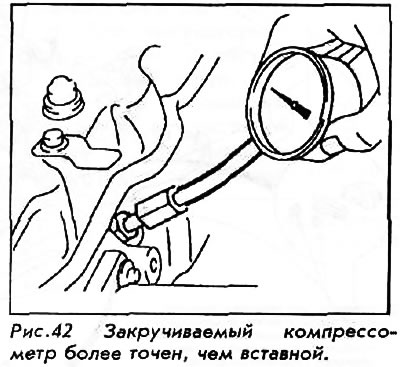As mentioned in the section "Tools and Equipment" Chapter 1, the screw type compression gauge is more accurate, although it takes longer to measure. It's worth it to get more accurate measurements. Perform the following procedures:
1. Warm up the engine to normal operating temperature.
2 Shut off the engine, then remove all spark plugs.
3. Disconnect the high voltage wire from the ignition coil.
4. Screw the compression tester tightly into the No. 1 spark plug hole.
WARNING: Be careful not to damage the threaded plug hole. On aluminum cylinder heads, the threads can easily be stripped.
5. Have an assistant release the gas pedal completely on both carbureted and fuel injected vehicles.
6. While you are watching the compression gauge, ask an assistant to start the engine two or three times for a short time (10 Seconds), using the ignition key.
7. Read the compression gauge at the end of each run and record the largest of these measurements. Repeat this procedure for each of the engine cylinders. Typically, new engines will have compression in the order of 1030-1170 kPa. This number decreases with age and wear. The number your test shows is not as important as the alignment between all the cylinders. Many engines work very well if the compression in all cylinders is about 725 kPa. The lower number simply shows the overall internal degradation. Such an engine is likely to burn some oil and may be somewhat more difficult to start.

Compare the largest values of all cylinders. Any deviation greater than 10% should be considered a sign of potential trouble. For example, for a 4-cylinder engine, if your compression measurements for cylinders 1 to 4 were: 930 kPa, 860 kPa, 620 kPa, and 860 kPa, then it would be fair to say that the third cylinder is inefficient and is almost certainly the cause of the burn. oil, harsh idling sound or high fuel consumption.
8. If the cylinder compression is unusually low, pour a spoonful of clean engine oil into the cylinder through the spark plug hole and repeat the compression measurement. If compression appears after adding oil, the piston rings or liner surface are damaged or worn. (The oil seals some leaks.) If the pressure remains low, the valves may be loose (need to work on valves), or is missing the cylinder head gasket next to that cylinder. If the compression in any two adjacent cylinders is low, and if adding oil does not help the compression, there is a cylinder head gasket leak. The presence of oil and coolant in the combustion chamber can directly result from this problem, as well as water droplets on the dipstick.
